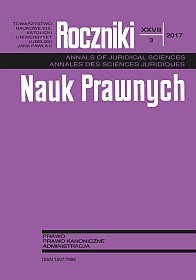The Celebration of Marriage coram assistente laico (can. 1112)
Abstract
Introduced after the Second Vatican Council, the norm permitting the lay person to be a qualified witness of marriage entered into a canonical form has not been yet further elaborated in Polish language. This article is an attempt to fill this gap in Polish canonical literature. The first part of the presentation is devoted to the development of the norm in post-conciliar legislation before the promulgation of the 1983 Code of Canon Law. The next part of this dissertation presents the conditions for delegation of lay person to assist at marriage in accordance with Can. 1112 of this Code: lack of priests and deacons, consent of the diocesan bishop with favorable vote of the conference of bishops and permission of the Holy See. The last presented issue is the duties of a delegated lay persons in connection with the task entrusted to them to prepare the nupturients for marriage, to verify their ability to conclude it, to preside over the rite and to take note of this fact in the church documentation.
References
Aznar Gil Federico R.: La Revision de la fromacanonica del matrimonio en el Concilio Vaticano II, Revista española de derecho canónico 38 (1982), s. 507-534.
Castaño Jose F.: Il sacramento del matrimonio, Roma: Tipolitografia Pioda 1994.
D’Auria Andrea: Le Facoltà speciali della Congregazione per l’Evangelizzazione dei Popoli, Ius Missionale 1 (2007), s. 257-261.
Gandía Barber Juan D.: La celebración del matrimonio ante asistente laico. Estudio Canónico-Litúrgico, Murcia: Ediciones Laborum 2008.
Góralski Wojciech: Małżeństwo kanoniczne, Warszawa: LexisNexis 2011.
Hurtado de Mendoza Dominguez Carlos: La asistencia al matrimonio canónico del testigo cualificado laico, Religion Y Cultura 55 (2008), s. 373-400.
Janczewski Zbigniew: Materia i forma sakramentu małżeństwa, Ius Matrimoniale 18 (24) 2013, s. 7-23.
Janczewski Zbigniew: Ustanawianie szafarzy sakramentów świętych w Kościele łacińskim i w Kościołach wschodnich, Warszawa: Wydawnictwo UKSW 2004.
Krukowski Józef: Komentarz do kan. 1112, [w:] Komentarz do Kodeksu Prawa Kanonicznego, t. III/2: Księga IV. Uświęcające zadanie Kościoła. Część I. Sakramenty. Część II. Pozostałe akty kultu Bożego. Część III. Miejsca i czasy święte, red. J. Krukowski, Poznań: Pallottinum 2011, s. 315.
L’adunanza «Plenaria» della Congregazione per il Culto Divino e la Disciplina dei Sacramenti (21-29 settembre 2001), Notitiae 37 (2001), s. 401-470.
La «Plenaria» della Congregazione per il Culto Divino e la Disciplina dei Sacramenti. 30 aprile – 4 maggio 1996. Roma, Notitiae 32 (1996), s. 373-507.
La «Plenaria» della Congregazione per il Culto Divino e la Disciplina dei Sacramenti.
-4 marzo 2005. Roma, Notitiae 41 (2005), s. 135-203.
Madtha Ambrose: Lay person as officant at marriage celebration according to the Code of Canon Law, Romae: Pontificia Universitas Urbaniana 1990.
Sabbarese Luigi: I laici „testi qualificati” per assistere al matrimonio. Aspetti storici, interpretativi e applicativi, [w:] Iustitiam et iudicium facere. Scritti in onore del Prof. Don Sabino Ardito, SDB, red. J. Pudmai Doss, M. Graulich, Roma: Libreria Ateneo Salesiano 2011, s. 49-65.
Słowikowska Anna: Uczestnictwo wiernych świeckich w liturgii Kościoła łacińskiego. Studium kanoniczne, Lublin: Towarzystwo Naukowe KUL 2014.
Zaborowski Marek: Forma nadzwyczajna zawarcia małżeństwa, Ius Matrimoniale 14 (20) 2009, s. 115-130.
Copyright (c) 2017 Roczniki Nauk Prawnych

This work is licensed under a Creative Commons Attribution-NonCommercial-NoDerivatives 4.0 International License.


